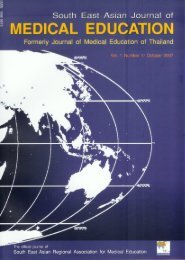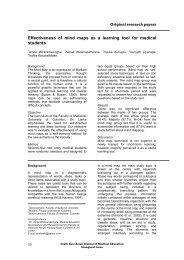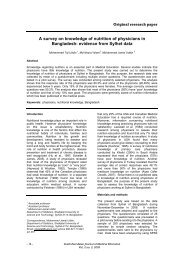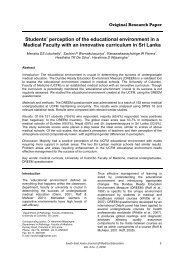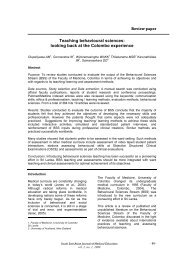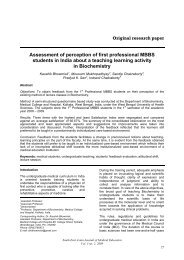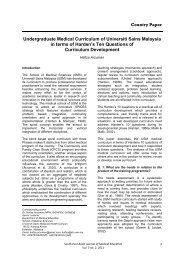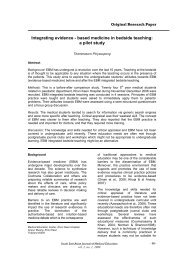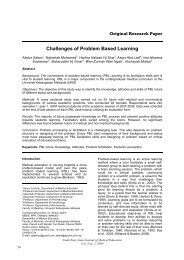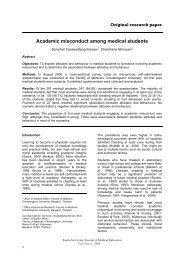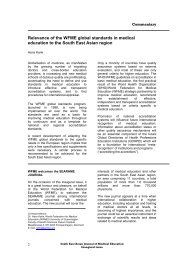Pattern of computer and internet use among medical students in ...
Pattern of computer and internet use among medical students in ...
Pattern of computer and internet use among medical students in ...
Create successful ePaper yourself
Turn your PDF publications into a flip-book with our unique Google optimized e-Paper software.
Two important po<strong>in</strong>ts pert<strong>in</strong>ent to MedicalEducation have been emphasized. First, thebio<strong>medical</strong> knowledge base is exp<strong>and</strong><strong>in</strong>g rapidly<strong>and</strong> cannot therefore be taught <strong>in</strong> its entirety.Second, self-directed learn<strong>in</strong>g needs to betaught to acquire life-long learn<strong>in</strong>g skills (Monyet al., 2004).In India, postgraduates <strong>in</strong> <strong>medical</strong> <strong>in</strong>stitutionsare the first-level practitioners <strong>of</strong> education,patient care <strong>and</strong> research. Changes <strong>in</strong> medic<strong>in</strong>e<strong>and</strong> IT (Information Technology) cont<strong>in</strong>ue to<strong>in</strong>fluence their learn<strong>in</strong>g. The aims <strong>of</strong> this surveyare to estimate the current level <strong>of</strong> <strong>computer</strong> <strong>use</strong><strong>and</strong> identify the tra<strong>in</strong><strong>in</strong>g needs <strong>of</strong>undergraduates <strong>and</strong> postgraduates.MethodsSett<strong>in</strong>gThe present cross sectional study was carriedout <strong>in</strong> 4 <strong>medical</strong> colleges <strong>in</strong> Mangalore,Daksh<strong>in</strong>a Kannada (South Kanara) district,Karnataka, India.SubjectsThe study population consisted <strong>of</strong> 500 <strong>medical</strong><strong>students</strong> (400 undergraduates, 100postgraduates / <strong>in</strong>terns) from 4 different <strong>medical</strong>colleges <strong>in</strong> Mangalore, 100 <strong>students</strong> each from1 st MBBS, 2 nd MBBS, pre-f<strong>in</strong>al MBBS, f<strong>in</strong>alMBBS & postgraduates / <strong>in</strong>terns. Before thestart <strong>of</strong> the study the <strong>in</strong>vestigator visited the<strong>medical</strong> colleges <strong>and</strong> got the prior permissionfrom authorities concerned. Prior to adm<strong>in</strong>istrat<strong>in</strong>gthe questionnaire, the class was addressedregard<strong>in</strong>g the purpose <strong>and</strong> process <strong>of</strong> datacollection. Then, 25 <strong>students</strong> were selected fromeach year <strong>of</strong> MBBS from each <strong>of</strong> the four<strong>medical</strong> colleges us<strong>in</strong>g simple r<strong>and</strong>om sampl<strong>in</strong>g.After written <strong>in</strong>formed consent from the studysubjects, the data was collected by personal<strong>in</strong>terview<strong>in</strong>g.Data was collected us<strong>in</strong>g a pre-tested semistructuredquestionnaire. The survey <strong>in</strong>strumentwas developed from the literature <strong>and</strong> <strong>in</strong>formaldiscussion with experts, <strong>and</strong> was pre-tested ona group <strong>of</strong> 25 <strong>students</strong>, 5 <strong>students</strong> from eachbatch <strong>of</strong> MBBS <strong>and</strong> then modified accord<strong>in</strong>gly.In the f<strong>in</strong>al analysis these 25 <strong>students</strong> wereexcluded.The study was approved by the InstitutionalEthical Committee <strong>of</strong> Kasturba Medical College,Mangalore. The data was analysed by us<strong>in</strong>gSPSS (Statistical Package for Social Sciences)version 11. The Chi square test for associationwas <strong>use</strong>d <strong>and</strong> P< 0.05 was considered asstatistically significant.ResultsDemographic pr<strong>of</strong>ile <strong>of</strong> <strong>students</strong>Demographic pr<strong>of</strong>ile <strong>of</strong> <strong>students</strong> is described <strong>in</strong>Table 1, which shows that maximum number <strong>of</strong><strong>students</strong> who participated <strong>in</strong> the study were <strong>of</strong>the age group 19-21 years constitut<strong>in</strong>g 173(34.6%). Among them 280 (56%) were males.Use <strong>of</strong> the <strong>computer</strong>Student’s ability <strong>and</strong> pattern <strong>of</strong> <strong>use</strong> <strong>of</strong> the<strong>computer</strong> is presented <strong>in</strong> Table 2. It wasobserved from the study that 158 (79%) 1 st <strong>and</strong>2 nd year <strong>medical</strong> <strong>students</strong> <strong>and</strong> 68 (68%)postgraduates / <strong>in</strong>terns had their own <strong>computer</strong>.The majority <strong>of</strong> postgraduates / <strong>in</strong>terns (40%)<strong>use</strong> the <strong>computer</strong> for general <strong>in</strong>formation <strong>and</strong> 31(31%) for thesis <strong>and</strong> research work whilemajority <strong>of</strong> 1 st <strong>and</strong> 2 nd year <strong>medical</strong> <strong>students</strong>(69.5%) <strong>use</strong> it for enterta<strong>in</strong>ment <strong>and</strong> 7 (3.5%)<strong>use</strong> the <strong>computer</strong> for other purposes such asdownload<strong>in</strong>g music, videos etc. This was foundto be statistically significant. The majority <strong>of</strong> 1 st<strong>and</strong> 2 nd year <strong>medical</strong> <strong>students</strong> (62%) <strong>use</strong><strong>computer</strong> at home or hostel most <strong>of</strong> the time,while 78 (39%) pre-f<strong>in</strong>al <strong>and</strong> f<strong>in</strong>al year <strong>medical</strong><strong>students</strong> <strong>use</strong> it <strong>in</strong> cyber cafés <strong>and</strong> 19 (9.5%)<strong>students</strong> did not specify a location. It wasobserved that most <strong>of</strong> 1 st <strong>and</strong> 2 nd year <strong>medical</strong><strong>students</strong> (42.5%) prefer the <strong><strong>in</strong>ternet</strong> for gett<strong>in</strong>grequired <strong>in</strong>formation while 69 (34.5%) pre-f<strong>in</strong>al<strong>and</strong> f<strong>in</strong>al year <strong>medical</strong> <strong>students</strong> prefer textbooks<strong>and</strong> 54 (27%) were non-specific about thepreferred medium, with choice <strong>of</strong> mediumdepend<strong>in</strong>g on the type <strong>of</strong> <strong>in</strong>formation searchedfor.Use <strong>of</strong> the <strong><strong>in</strong>ternet</strong>The student’s <strong>use</strong> <strong>of</strong> <strong><strong>in</strong>ternet</strong> services <strong>and</strong>resources is shown <strong>in</strong> Table 3. It was observedthat majority <strong>of</strong> 1 st <strong>and</strong> 2 nd year <strong>medical</strong> <strong>students</strong>(82%) first started us<strong>in</strong>g the <strong><strong>in</strong>ternet</strong> at homebefore arriv<strong>in</strong>g at college while 36 (36%)postgraduates / <strong>in</strong>terns started after arriv<strong>in</strong>g atcollege. Majority <strong>of</strong> postgraduates/ <strong>in</strong>terns 54(58.1%) preferred <strong><strong>in</strong>ternet</strong> over text booksbeca<strong>use</strong> it accessed the latest knowledge <strong>and</strong>37 (22.2%) 1 st <strong>and</strong> 2 nd year <strong>medical</strong> <strong>students</strong>preferred it beca<strong>use</strong> <strong>of</strong> easy accessibility, while20 (12%) thought that they preferred the <strong><strong>in</strong>ternet</strong>for multiple reasons. When <strong>use</strong>d for studypurpose, 171 (85.5%) pre-f<strong>in</strong>al <strong>and</strong> f<strong>in</strong>al year<strong>medical</strong> <strong>students</strong> <strong>use</strong> the <strong><strong>in</strong>ternet</strong> for <strong>in</strong>formation<strong>of</strong> recent advances. Majority <strong>of</strong> the <strong>students</strong> 98(98%) postgraduates / <strong>in</strong>terns <strong>and</strong> 185 (92.5%)1 st <strong>and</strong> 2 nd year <strong>medical</strong> <strong>students</strong> agreed withthe fact that <strong>computer</strong> <strong>and</strong> <strong><strong>in</strong>ternet</strong> <strong>use</strong> shouldbe encouraged <strong>in</strong> teach<strong>in</strong>g <strong>in</strong>stitutions. 77 (77%)postgraduates/ <strong>in</strong>terns were satisfied with<strong>computer</strong> assisted teach<strong>in</strong>g while 40 (20%) 1 st<strong>and</strong> 2 nd year <strong>students</strong> were not. It was observedthat majority <strong>of</strong> 1 st <strong>and</strong> 2 nd year <strong>medical</strong> <strong>students</strong>101 (50.5%) <strong>use</strong> the <strong><strong>in</strong>ternet</strong> most tocommunicate socially <strong>and</strong> 54 (27%) <strong>use</strong> it forenterta<strong>in</strong>ment, while 42 (21%) pre-f<strong>in</strong>al <strong>and</strong> f<strong>in</strong>alyear <strong>medical</strong> <strong>students</strong> <strong>use</strong> it to engage <strong>in</strong> workfor classes <strong>and</strong> only 10 (5%) did not specify the<strong>use</strong>. E-mail was the favorite communication tool<strong>use</strong>d by postgraduates / <strong>in</strong>terns (87%);whereas, 45 (22.5%) 1 st <strong>and</strong> 2 nd year <strong>medical</strong><strong>students</strong> <strong>use</strong>d <strong>in</strong>stant messag<strong>in</strong>g. It wasobserved that majority (126) <strong>of</strong> pre f<strong>in</strong>al <strong>and</strong> f<strong>in</strong>alyear <strong>medical</strong> <strong>students</strong> (63%), spend less than 3hours with the <strong>computer</strong> <strong>and</strong> go<strong>in</strong>g onl<strong>in</strong>e <strong>in</strong> aSouth East Asian Journal <strong>of</strong> Medical EducationVol. 2 no 2, 2008- 19 -




